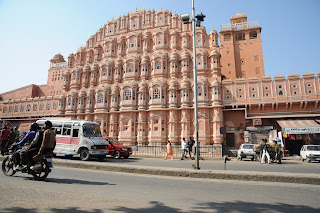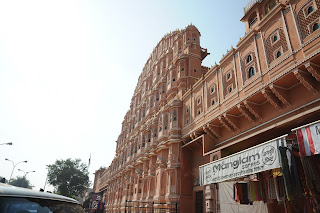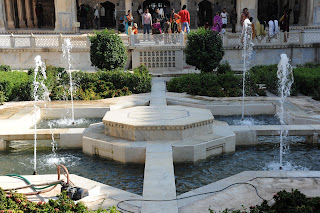The Hawa Mahal or palace of the winds was built in 1799 by Maharjah Sawai Pratap Singh, and designed by Lal Chand Usta in the form of the crown of Krishna, the hindu god. Its five storey exterior has 953 small windows called " jharokhas " that are decorated with intricate lattice work. The interior of the lattice work was to allow the royal ladies to watch the world go by, down below without being seen, since they had to observe strict "purdah" (face cover).
Built from red and pink sandstone, the palace is situated on the main thoroughfare, in the heart of Jaipur. It forms part of the city palace, and extends to the "zenana" or womens chambers.
El Hawa Mahal o palacio de los vientos fue construido en 1799 por el Majaraja Sawai Pratap Singh y disenado por Lal Chand Usta en la forma de corona del dios hindu, Krishna. Su exterior de cinco plantas tiene 953 ventanas llamadas " jharokhas " decoradas con un enrejado complejo. El interior del enrejado era para permitir las mujeres reales ver el mundo afuera sin ser vistas, ya que tenian que observar "purdah" estricta (cara tapada).
Construido de piedra arenisca roja y rosa esta ubicada en la calle principal del centro de Jaipur. Forma parte del " City Palace ", y extiende hasta la " zenana " ( aposentos femeninos ).
A journal of my adventures through India. Un diario de mis adventuras por la India.
Sunday, 12 December 2010
THE AMBER FORT
The Amber fort is located 11km from the centre of Jaipur. It is known for its unique style, blending both hindu and muslim (Mughal) elements. The fort borders the Maota lake and was built over an earlier structure, although the palace, such as it is today was commenced by Raja Man Singh around 1592. The initial structure of the fort was completed by his descendant Jai Singh I and was modified by succesive rulers over the next 150 years.
The structure which is known as "Amber Fort" was initially a palace complex within the original fort that is today known as Jaigarh fort. Amber fort is constructed from red and white sandstone. The fort contrasts from a rugged, defensive exterior to an ornate and lavish interior decorated in both hindu and muslim styles. The walls of the interior of the fort are covered with murals and frescoes depicting everyday life. I will let the Nikons do the rest of the work.
El Fuerte Amber esta ubicado a 11km del centro de Jaipur. Es conocido por su estilo unico, combinando elementos hindu y musulman (Mughal). El fuerte esta alado del lago Maota y fue construido sobre un emplacamiento anterior, aunque el palacio, tal y como esta hoy lo empezo Raja Man Singh alrededor de 1592. La estructura inicial del fuerte fue terminado por su descendiente Jai Singh I y fue modificado por soberanos sucesivos durante los proximos 150 anos.
La estructura conocida como el "Fuerte Amber" era inicialmente un palacio dentro del fuerte original conocido hoy como el fuerte Jaigarh. El Fuerte Amber esta construido de piedra arenisca roja y blanca. El fuerte contrasta de un bruto y defensivo exterior a un interior abundante y vistoso decorado con estilos hindues y musulman. Las paredes del interior del fuerte estan cubiertos con murales y frescos mostrando la vida cotidiana. Dejare que las Nikons acaben el trabajo.
The structure which is known as "Amber Fort" was initially a palace complex within the original fort that is today known as Jaigarh fort. Amber fort is constructed from red and white sandstone. The fort contrasts from a rugged, defensive exterior to an ornate and lavish interior decorated in both hindu and muslim styles. The walls of the interior of the fort are covered with murals and frescoes depicting everyday life. I will let the Nikons do the rest of the work.
El Fuerte Amber esta ubicado a 11km del centro de Jaipur. Es conocido por su estilo unico, combinando elementos hindu y musulman (Mughal). El fuerte esta alado del lago Maota y fue construido sobre un emplacamiento anterior, aunque el palacio, tal y como esta hoy lo empezo Raja Man Singh alrededor de 1592. La estructura inicial del fuerte fue terminado por su descendiente Jai Singh I y fue modificado por soberanos sucesivos durante los proximos 150 anos.
La estructura conocida como el "Fuerte Amber" era inicialmente un palacio dentro del fuerte original conocido hoy como el fuerte Jaigarh. El Fuerte Amber esta construido de piedra arenisca roja y blanca. El fuerte contrasta de un bruto y defensivo exterior a un interior abundante y vistoso decorado con estilos hindues y musulman. Las paredes del interior del fuerte estan cubiertos con murales y frescos mostrando la vida cotidiana. Dejare que las Nikons acaben el trabajo.
THE JANTAR MANTAR
The Jantar Mantar is a collection of architectural astronomical instruments built by the Maharajah Jai Singh II at his new capital between 1727-1734. He had a total of five constructed(one being in Delhi), but it is the one in Jaipur which is the largest and best preserved. The name comes from Jantar(instrument) and Mantar(formula).
The observatory consists of 14 major geometric devices for measuring time, predicting eclipses, tracking stars' locations as the earth orbits around the sun, ascertaining the declinations of planets and determining the celestial altitudes and related ephemerides. Each is a fixed and 'focused' tool.
The Samrat Yantra, the largest instrument is 27m high, its shadow carefully plotted to tell the time of day. Its face is carefully angled at 27o, the latitude of Jaipur. The Hindu Chhatri(small cupola) on top is used as a platform for announcing eclipses and the arrival of monsoons.
Built from local stone and marble, each instrument carries an astronomical scale, generally marked on the marble inner lining. Bronze tablets, all extraordinarily accurate, were also employed. Thoroughly restored in 1901, the Jantar Mantar was declared a national monument in 1948.
El Jantar Mantar es una coleccion de instrumentos architecturales astronomicos construidos por el Majaraja Jai Singh II en su nueva capital entre 1727-1734. Hizo construir cinco(uno esta en Delhi), pero el de Jaipur es el mas grande y mejor conservado. El nombre viene de Jantar(instrumento) y Mantar(formula).
El observatorio consiste en 14 aparatos geometricos para la mediacion del tiempo, la prediccion de los eclipses, el seguimiento de las ubicaciones de las estrellas en su trayecto alrededor del sol, la determinacion de las declinaciones de los planetas y la determinacion de las altitudes celestiales y efimerides relacionadas. Cada una es un instrumento fijo y 'enfocado'.
El Samrat Yantra, es el instrumento mas grande con 27m de altura, su sombra cuidadosamente trazada para dar la hora del dia. Su cara angulada a 27o, la latitud deJaipur. El Hindu Chhatri(pequena cupula) en la cima es usada como plataforma para anunciar eclipses y la llegada de monsones.
Construida de piedra y marmol local, cada instrumento tiene una escala astronomica, generalmente marcada en el reborde de marmol interior. Tablas de bronze, todas extraordinariamente precisas, tambien fueron empleadas. Totalmente restaurado en 1901, el Jantar Mantar fue declarado monumento nacional en 1948.
The observatory consists of 14 major geometric devices for measuring time, predicting eclipses, tracking stars' locations as the earth orbits around the sun, ascertaining the declinations of planets and determining the celestial altitudes and related ephemerides. Each is a fixed and 'focused' tool.
The Samrat Yantra, the largest instrument is 27m high, its shadow carefully plotted to tell the time of day. Its face is carefully angled at 27o, the latitude of Jaipur. The Hindu Chhatri(small cupola) on top is used as a platform for announcing eclipses and the arrival of monsoons.
Built from local stone and marble, each instrument carries an astronomical scale, generally marked on the marble inner lining. Bronze tablets, all extraordinarily accurate, were also employed. Thoroughly restored in 1901, the Jantar Mantar was declared a national monument in 1948.
El Jantar Mantar es una coleccion de instrumentos architecturales astronomicos construidos por el Majaraja Jai Singh II en su nueva capital entre 1727-1734. Hizo construir cinco(uno esta en Delhi), pero el de Jaipur es el mas grande y mejor conservado. El nombre viene de Jantar(instrumento) y Mantar(formula).
El observatorio consiste en 14 aparatos geometricos para la mediacion del tiempo, la prediccion de los eclipses, el seguimiento de las ubicaciones de las estrellas en su trayecto alrededor del sol, la determinacion de las declinaciones de los planetas y la determinacion de las altitudes celestiales y efimerides relacionadas. Cada una es un instrumento fijo y 'enfocado'.
El Samrat Yantra, es el instrumento mas grande con 27m de altura, su sombra cuidadosamente trazada para dar la hora del dia. Su cara angulada a 27o, la latitud deJaipur. El Hindu Chhatri(pequena cupula) en la cima es usada como plataforma para anunciar eclipses y la llegada de monsones.
Construida de piedra y marmol local, cada instrumento tiene una escala astronomica, generalmente marcada en el reborde de marmol interior. Tablas de bronze, todas extraordinariamente precisas, tambien fueron empleadas. Totalmente restaurado en 1901, el Jantar Mantar fue declarado monumento nacional en 1948.
TEXTILES, BLOCK PRINTING AND SARIS
In between the Gatore crematorium and the water palace, I got Abdullah to take me to the Moghul textile emporium, where apart from being able to purchase anything textile( wall hangings, carpets, saris, bedspreads and made to measure suits, in any type of material etc), you have the opportunity to see the artesans in action.In the first photos you will see the various stages of 'block printing'. This involves the stamping of an image(in this case an elephant), using five different stamps, carved from teak and superimposing them one after the other with an incredible precision, using different colour vegetable dyes. The finished print is then rinsed first in salt water and then in fresh water. The result being a multicoloured image, which will not fade or shrink when washed.This is done on a variety of materials from cotton, muslin and silk. The following images show the detailed sewing of various beads and mirroirs to produce anything from wall hangings to bed clothes and cushions, to produce unique, one-off images of Ganesha, the elephant god. After spending a good two hours watching and buying, I asked Abdullah to take me back to the hotel.
It was here that I made an executive decision to return home. There were several factors in my decision to cut short my visit. The first was that my father in law's illness had taken a drastic turn for the worse and I felt it my moral duty to be next to my wife for what could be a difficult few days?, weeks? ahead, especially in this festive period( which I personally loathe, which was one of the reasons I came to India at this time of the year); another one was after just four weeks the misery and suffering which I was seeing on a daily basis was begining to affect me deeply, seeing how the so called ' untouchables' were living daily in the most abject conditions was bringing me down day by day. Another very important factor was that I was losing weight at an alarming rate(4kg in as many weeks). I told Abdullah this and he said that he would drive me to Delhi to grab the earliest flight I could arrange. I said that this was cool, but that I still had two important visits I had to make and that we would leave for Delhi the day after tomorrow.
Entre el crematorio Gatore y el palacio de agua, le hice a Abdullah llevarme al emporio textil Moghul, donde aparte de poder comprar qualquier elaboracion textil(colgantes para la pared, alfombras, saris, juegos de cama y hasta trajes hechos a medida de qualquier genero etc) tienes la oportunidad de ver los artesanos en su trabajo. Las primeras fotos que se ven son las varias etapas de'imprimir con bloques'. Esto consiste en el marcar con estampilla( en este caso un elefante), usando cinco estampillas diferentes, esculpidos de teja y sobreponiendolos uno encima del otro con una exactitud impresionante, usando tintes vegetales de colores diferentes. El estampido acabado se lava primero en agua salada y despues se aclara en agua fresca. El resultado es un imagen de multicolor, que ni se destine o encoje al lavar. Esto se practica en varios generos desde algodon, muselina y hasta en seda. Los siguientes imagenes muestran el cosido detallado de varios tipos de adornos y espejos para decorar qualquier adorno, desde colgantes para la pared, ropa de cama, y cojines para producir imagenes unicos del dios elefante Ganesha. Despues de haber pasado unas dos horas observando y comprando, le pedi a Abdullah que me llevase de vuelta al hotel. Fue aqui donde decidi tomar la decision ejecutiva de volver a casa. La primera, mas importante razon era que la enfermedad de mi suegro habia empeorado drasticamente y decidi que era mi deber estar alado de mi mujer para lo que serian unos dias? o semanas? importantes, sobre todo en esta epoca navidena(que yo personalmente abhorrezco y por eso decidi venirme a la India en estas fechas); otra razon era que despues de quatro semanas la miseria y sufrimento de que era testigo a diario me estaba empezando afectar profundamente, viendo como los llamados 'intocables' vivian en las condiciones mas miserables, que ningun ser humano tiene porque aguantar me estaban causando una depresion indescriptible. Otro factor muy importante a nivel personal, es que estaba perdiendo peso a una velocidad alarmante(4kg en tantas semanas). Se lo dije a Abdullah y me dijo que me llevaria a Delhi a coger el primer vuelo que yo podria organizar. Le dije que bien, pero que aun tenia que hacer dos visitas importantes y que saldriamos pasado manana.
It was here that I made an executive decision to return home. There were several factors in my decision to cut short my visit. The first was that my father in law's illness had taken a drastic turn for the worse and I felt it my moral duty to be next to my wife for what could be a difficult few days?, weeks? ahead, especially in this festive period( which I personally loathe, which was one of the reasons I came to India at this time of the year); another one was after just four weeks the misery and suffering which I was seeing on a daily basis was begining to affect me deeply, seeing how the so called ' untouchables' were living daily in the most abject conditions was bringing me down day by day. Another very important factor was that I was losing weight at an alarming rate(4kg in as many weeks). I told Abdullah this and he said that he would drive me to Delhi to grab the earliest flight I could arrange. I said that this was cool, but that I still had two important visits I had to make and that we would leave for Delhi the day after tomorrow.
Entre el crematorio Gatore y el palacio de agua, le hice a Abdullah llevarme al emporio textil Moghul, donde aparte de poder comprar qualquier elaboracion textil(colgantes para la pared, alfombras, saris, juegos de cama y hasta trajes hechos a medida de qualquier genero etc) tienes la oportunidad de ver los artesanos en su trabajo. Las primeras fotos que se ven son las varias etapas de'imprimir con bloques'. Esto consiste en el marcar con estampilla( en este caso un elefante), usando cinco estampillas diferentes, esculpidos de teja y sobreponiendolos uno encima del otro con una exactitud impresionante, usando tintes vegetales de colores diferentes. El estampido acabado se lava primero en agua salada y despues se aclara en agua fresca. El resultado es un imagen de multicolor, que ni se destine o encoje al lavar. Esto se practica en varios generos desde algodon, muselina y hasta en seda. Los siguientes imagenes muestran el cosido detallado de varios tipos de adornos y espejos para decorar qualquier adorno, desde colgantes para la pared, ropa de cama, y cojines para producir imagenes unicos del dios elefante Ganesha. Despues de haber pasado unas dos horas observando y comprando, le pedi a Abdullah que me llevase de vuelta al hotel. Fue aqui donde decidi tomar la decision ejecutiva de volver a casa. La primera, mas importante razon era que la enfermedad de mi suegro habia empeorado drasticamente y decidi que era mi deber estar alado de mi mujer para lo que serian unos dias? o semanas? importantes, sobre todo en esta epoca navidena(que yo personalmente abhorrezco y por eso decidi venirme a la India en estas fechas); otra razon era que despues de quatro semanas la miseria y sufrimento de que era testigo a diario me estaba empezando afectar profundamente, viendo como los llamados 'intocables' vivian en las condiciones mas miserables, que ningun ser humano tiene porque aguantar me estaban causando una depresion indescriptible. Otro factor muy importante a nivel personal, es que estaba perdiendo peso a una velocidad alarmante(4kg en tantas semanas). Se lo dije a Abdullah y me dijo que me llevaria a Delhi a coger el primer vuelo que yo podria organizar. Le dije que bien, pero que aun tenia que hacer dos visitas importantes y que saldriamos pasado manana.
Subscribe to:
Posts (Atom)

















































